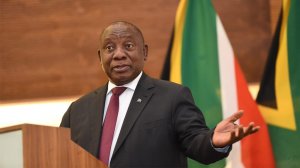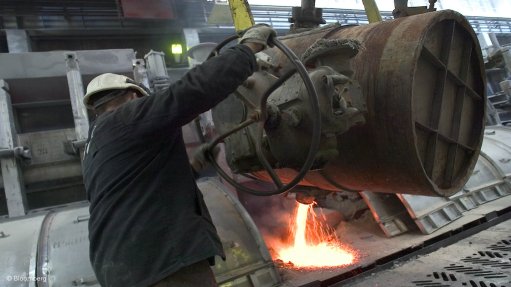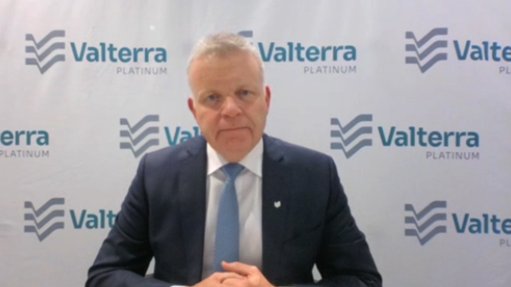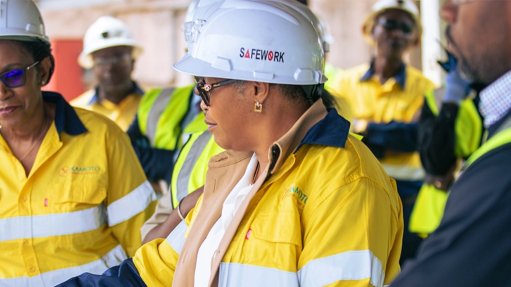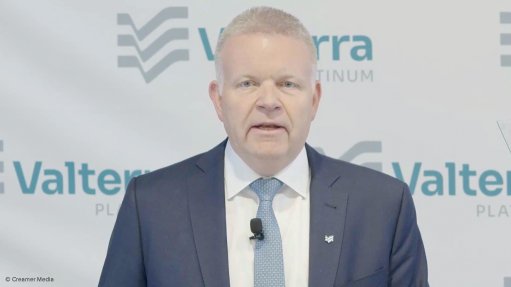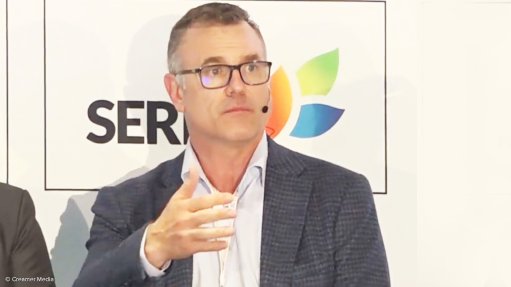Ramaphosa moves to revitalise mining, create certainty
JOHANNESBURG (miningweekly.com) – It is imperative that South Africa restores investment and exploration levels in the mining sector as mining and mineral beneficiation activities have significant potential to drive long term growth, exports and job growth, President Cyril Ramaphosa said in his economic stimulus and recovery plan speech on Friday.
He said that following extensive consultation that involved industry players, communities, labour and government, the Cabinet had approved the long-awaited revised Mining Charter, which will be gazetted next week.
“This will revitalise the mining industry and provide certainty to investors while charting a sustainable path towards a transformed and inclusive industry,” the President said.
“The gazetting of the charter will entrench the regulatory certainty necessary for the growth, development and competitiveness of the industry, and ensure South Africa remains an investment destination of choice,” Mineral Resources Minister Gwede Mantashe said in a separate statement to Creamer Media’s Mining Weekly Online.
Ramaphosa said that Parliament would be requested not to proceed with the Mineral and Petroleum Resources Development Act Amendment Bill, which had contributed to sector uncertainty, and separate legislation for the regulation of the oil and gas industry would be drafted through the government’s legislative process.
To reduce the cost of doing business, to boost exports and to make South African industry more competitive, government had begun a review of various administered prices, starting with electricity, port and rail tariffs.
In his State of the Nation Address in February, Ramaphosa announced a range of measures that would be initiated to set the country on a new path of growth, employment and transformation.
Since then, the government, he said, had taken decisive steps to rebuild investor confidence, end corruption and state capture, restore good governance at State-owned enterprises and strengthen critical public institutions.
Yet, as was evident from the contraction of the economy in the first two quarters of the year, South Africa’s economic difficulties were severe and would take an extraordinary effort and time to overcome.
For several years, the economy had failed to grow at the pace needed to create enough jobs or lift the country’s people out of poverty.
Public finances had been constrained, limiting the ability of government to expand its investment in economic and social development.
In recent months, the structural weaknesses in the economy had been made worse by global factors such as a rising oil price, weakening sentiment towards emerging markets and deteriorating trade relations between the US and other major economies.
“This has negatively affected South Africans,” Ramaphosa said, adding that it was in response to these factors, that the Cabinet had adopted an economic stimulus and recovery plan consisting of measures to ignite economic activity, restore investor confidence, prevent further job losses and create new jobs, and address some urgent challenges that affect the conditions faced by vulnerable groups.
“The measures we are announcing give priority to those areas of economic activity that will have the greatest impact on youth, women and small businesses,” the President said.
The broad parts of the stimulus and recovery plan are:
- implementation of growth enhancing economic reforms;
- reprioritisation of public spending to support job creation;
- the establishment of an Infrastructure Fund;
- the addressing of urgent and pressing matters in education and health; and
- investing in municipal social infrastructure improvement.
The President said that it was generally agreed that for the economy to grow at a rate that would lead to job creation on a meaningful scale, the country needed to increase the levels of investment significantly.
“We are decisively and rapidly accelerating the implementation of key economic reforms that will unlock greater investment in important growth sectors. These reforms include immediate changes approved by Cabinet to South Africa's visa regime,” he said.
Within the next few months, amendments would be made to regulations on the travel of minors, the list of countries requiring visas to enter South Africa will be reviewed, an e-visas pilot will be implemented, and the visa requirements for highly skilled foreigners will be revised.
These measures had the potential to boost tourism and make business travel a lot more conducive.
Tourism continued to be a great job creator and through these measures, many more tourists would visit South Africa.
Within the next few weeks, government would initiate the process for the allocation of high-demand radio spectrum to enable licensing.
This would unlock significant value in the telecommunications sector, increase competition, promote investment and reduce data costs.
Lower data costs would also provide relief for poor households and increase the overall competitiveness of the South African economy.
Other measures include expanding procurement from small business and cooperatives, as well as using trade measures – within World Trade Organisation rules – to protect poultry and other sensitive sectors and a vigorous crackdown on illegal imports.
The central element of the economic stimulus and recovery plan was the reprioritisation of spending towards activities with the greatest impact on economic growth, domestic demand and job creation, with a particular emphasis on township and rural economies, women and youth.
“Our government has limited fiscal space to increase spending or borrowing, it is imperative that we make sure that the resources that we do have are used to the greatest effect.
“The reprioritisation of spending we are outlining as part of this stimulus and recovery plan will take place within the current fiscal framework and in line with the normal budgetary process,” the President said.
Re-prioritised funding would be directed towards investments in agriculture and economic activity in townships and rural areas, with agriculture acknowledged as a massive potential job generator in the immediate and long term.
The interventions would include a package of support measures for black commercial farmers to increase their entry into food value chains through access to infrastructure like abattoirs and feedlots.
Blended finance would be mobilised from the Land Bank, Industrial Development Corporation and commercial banks.
The Land Bank, the President disclosed, was currently concluding transactions to create employment opportunities in the agricultural sector over the next three to five years.
A significant portion of the funding would go towards export-oriented crops that are highly labour intensive.
Government would finalise the signing of 30-year leases to enable farmers to mobilise funding for agricultural development.
As part of the work to develop agriculture and ensure effective land reform, Ramaphosa said he had appointed an advisory panel on land reform that would guide the Inter-Ministerial Committee on Land Reform, chaired by Deputy President David Mabuza.
The ten-person panel would advise government on the implementation of a fair and equitable land reform process that redressed the injustices of the past, increased agricultural output, promoted economic growth and protected food security.
Further details of the mandate and composition of the panel would be made available in a separate statement.
In the second instance, reprioritised funding would also be re-directed towards stimulating economic activity in townships and rural areas.
“We have prioritised the revitalisation of three regional and 26 township industrial parks as catalysts for broader economic and industrial development in townships and rural areas. A township and rural entrepreneurship fund is being established to provide finance to either scale up existing projects or provide start-up capital for new projects,” Ramaphosa said.
Resources, in the third instance, would be redirected towards addressing immediate challenges in health and education, which were critical to the health, wellbeing and productivity of the people of South Africa.
Arising from the priorities identified at the meeting of the President’s Coordinating Council earlier this week, additional funds would be directed to addressing the dire state of sanitation facilities in many public schools, ensuring the completion of 1 100 sanitation projects in the current financial year.
To address some of the shortages in hospitals, funding was being made available immediately to buy beds and linen, while the Minister of Health and the National Health Council would immediately fill 2 200 critical medical posts, including nurses and interns.
In total, the plan would result in reprioritised expenditure and new project level funding of around R50-billion.
The Minister of Finance would provide more detail about the final amounts involved and the specific areas affected during the Medium Term Budget Policy Statement next month.
The stimulus and recovery plan, he said, prioritised infrastructure spending as a critical driver of economic activity.
Infrastructure expansion and maintenance had the potential to create jobs on a large scale, attract investment and lay a foundation for sustainable economic expansion.
With a view to unlocking the potential to create more jobs on a large scale, the South Africa Infrastructure Fund had been established to transform the approach to the roll-out, building and implementation of infrastructure projects.
“The lessons we learnt in the 2010 World Cup infrastructure roll-out will stand us in good stead as we set out this fund,” the President added.
The South Africa Infrastructure Fund would reduce the current fragmentation of infrastructure spend and ensure more efficient and effective use of resources.
The private sector would be invited to enter into meaningful partnerships with government in this fund.
The contribution from the fiscus towards the Infrastructure Fund over the medium-term expenditure framework period would be more than R400-billion, which would be used to leverage additional resources from developmental finance institutions, multilateral development banks and private lenders and investors.
To ensure these funds were used effectively and that projects were completed on time and on budget, a dedicated Infrastructure Execution Team in The Presidency with extensive project management and engineering expertise to assist with project design and oversee implementation was being established to identify and quantify ‘shovel ready’ public sector projects, such as roads and dams, and engage the private sector to manage delivery.
The role of the Presidential Infrastructure Coordinating Commission would be strengthened to ensure improved coordination across the three spheres.
As part of the reprioritisation of spending, additional infrastructure funding would be directed towards provincial and national roads, human settlements, water infrastructure, schools, student accommodation and public transport.
In support of the stimulus efforts, the Industrial Development Corporation would be targeting approvals of up to R20-billion over 12 months, an increase of 20% on the previous year.
This funding would target the productive sectors of the economy, including manufacturing, mining, industrial infrastructure and sectors in distress.
“We also need short term municipal investments to address the challenges that our people face. We have identified 57 priority pilot municipalities in order to unlock infrastructure spending in the short term. This spending will cover, among other things, sewerage purification and reticulation, refuse sites, electricity reticulation and water reservoirs,” Ramaphosa said.
Cutting across all these measures were series of interventions to ensure that growth was labour intensive and that young people in particular were drawn into the labour market.
Some of the measures included the extension of the Employment Tax Incentive for a further ten years, with a review after five years, greater support for public employment programmes, additional support for the clothing and textiles sector, and the use of funds from the Unemployment Insurance Fund to support labour activation programmes.
“Igniting economic activity requires partnership and collaboration. It must be a national effort in which all of us work together to restore our economy to growth in the immediate term and prepare the ground for sustainable, inclusive growth into our future. We have held consultations with leaders from business and labour on this plan. We are encouraged by the support they have pledged for the measures outlined and many have undertaken to provide resources and expertise to ensure its success.
“We continue to draw on the guidance and support of bodies like the National Planning Commission, which will soon release its own guidance on focal areas to stimulate the economy, and government will continue to coordinate its work with formations like the CEO Initiative. We are certain that the measures we have outlined here will complement the deliberations at the forthcoming Jobs Summit.
“We are certain that these interventions will help to put the economy on a far firmer footing as current investors and potential investors convene in Johannesburg for the Investment Conference at the end of October. As South Africans, we have confronted challenges far greater than this before.
“By working together, we managed to end a seemingly intractable conflict and set our country on the path to a peaceful transition to democracy. Now, we have it within us to come together once more and forge a new path of growth, jobs and transformation. We are confident that the four elements of our economic stimulus and recovery package will play a decisive role in reversing the recent contraction of the South African economy. Together, we are taking bold and concrete measures to ensure a clear and sustained improvement in the lives of all South Africans,” Ramaphosa said.
Comments
Press Office
Announcements
What's On
Subscribe to improve your user experience...
Option 1 (equivalent of R125 a month):
Receive a weekly copy of Creamer Media's Engineering News & Mining Weekly magazine
(print copy for those in South Africa and e-magazine for those outside of South Africa)
Receive daily email newsletters
Access to full search results
Access archive of magazine back copies
Access to Projects in Progress
Access to ONE Research Report of your choice in PDF format
Option 2 (equivalent of R375 a month):
All benefits from Option 1
PLUS
Access to Creamer Media's Research Channel Africa for ALL Research Reports, in PDF format, on various industrial and mining sectors
including Electricity; Water; Energy Transition; Hydrogen; Roads, Rail and Ports; Coal; Gold; Platinum; Battery Metals; etc.
Already a subscriber?
Forgotten your password?
Receive weekly copy of Creamer Media's Engineering News & Mining Weekly magazine (print copy for those in South Africa and e-magazine for those outside of South Africa)
➕
Recieve daily email newsletters
➕
Access to full search results
➕
Access archive of magazine back copies
➕
Access to Projects in Progress
➕
Access to ONE Research Report of your choice in PDF format
RESEARCH CHANNEL AFRICA
R4500 (equivalent of R375 a month)
SUBSCRIBEAll benefits from Option 1
➕
Access to Creamer Media's Research Channel Africa for ALL Research Reports on various industrial and mining sectors, in PDF format, including on:
Electricity
➕
Water
➕
Energy Transition
➕
Hydrogen
➕
Roads, Rail and Ports
➕
Coal
➕
Gold
➕
Platinum
➕
Battery Metals
➕
etc.
Receive all benefits from Option 1 or Option 2 delivered to numerous people at your company
➕
Multiple User names and Passwords for simultaneous log-ins
➕
Intranet integration access to all in your organisation




